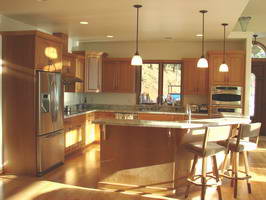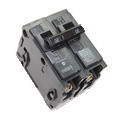Replacing a Circuit Breaker – What Size Should Be Used
 '; ';
|
If a circuit breaker is tripping off, can a larger one be installed to solve the problem? How to Replace a Circuit Breaker: Common Mistakes When Replacing Circuit Breakers and How to Avoid Them. © By: Dave Rongey |
Guide to Replacing a Circuit Breaker
Electrical Question: If a circuit breaker is tripping off, can a larger one be installed to solve the problem?
- My house was built in 1977 and I have a 14 gauge wire to a bathroom with modern appliances such as hair dryers.
- The circuit is tripping a 15 amp circuit breaker.
- I hired an Electrician who said he “remedied” the problem by replacing the 15 amp circuit breaker with a 20 amp circuit breaker.
- Is this compatible with NEC code?
This electrical wiring question came from: Stephen, a Homeowner from Nantucket, Massachusetts.
Additional Comments: Excellent service for the homeowner with limited electrical knowledge.
Dave’s Reply:
Thanks for your electrical wiring question Stephen.
The Process of Replacing a Circuit Breaker
- Skill Level: Advanced – Not recommended for homeowners or non experienced electricians, Best performed by a Licensed Electrical Contractor or Certified Electrician.
- Tools Required: Electricians pouch of hand tools, voltage tester and protective safety gear and arc flash protection.
- Estimated Time: Depends on the make and model of the panel and the condition of the existing electrical circuit breakers and wiring methods.
- Precaution: For safety the main circuit breaker or power source should be turned off and disconnected before replacing a circuit breaker.
- IMPORTANT: Depending on the electrical panel internal components may still be energized when the main breaker is in the off position.
- NOTE: Making changes to electrical panel or electric circuits should with local and national electrical codes, with a permit and be inspected.
Common Mistakes When Replacing Circuit Breakers and How to Avoid Them
- Replacing any circuit breaker with a larger one is extremely dangerous and in violation of the NEC Code.
- Circuit breakers protect the circuit from overloading, therefore replacing any circuit breaker with a larger one can cause the circuit wiring to overheat which can lead to a fire.
- As mentioned in this electrical question, the original 15 amp circuit breaker size was correct. The correct way to remedy the problem of overloading the existing 15 amp circuit is to install a new 20 amp circuit and place the required GFCI protection on the new circuit or install a GFCI outlet in the bathroom.
Selecting the Circuit Breaker Size
- Circuit breakers are sized according to the following electrical circuit factors:
- The type of insulation of the wire or cable that has been installed.
- The gauge of the electrical wire circuit conductor.
- The wire conductor type, which is either copper or aluminum.
- The specifications of electrical equipment that will be powered.
- Once these factors have been determined then the NEC Wire Size Table is used to find the circuit amperage rating which will determine the circuit breaker size.
How to Replace a Circuit Breaker
- Schedule and prepare the occupants and the home to be without electrical power.
- If the project will not be done during daylight then make sure to provide battery powered light sources for home occupants and for yourself.
- When the home and occupants are ready, turn off the main breaker power source to the panel.
- Remove the panel covering from the circuit breakers.
- Turn off the circuit breaker that will be replaced.
- Test the terminal where the circuit wire is attached to the circuit breaker to make sure power the power is off.
- Unfasten and remove the wire that is attached to the circuit breaker wire terminal.
- Circuit breakers are removed by first releasing the opposite end of the wire terminal while hinging it out, and then releasing the wire terminal end and pulling the breaker outward.
- Install the new replacement circuit breaker using the reverse method used for removing the old circuit breaker.
- Make sure the circuit breaker is fully installed.
- Firmly attach the circuit wire to the circuit breaker terminal.
- Prepare to install the panel cover by making sure to clear any interior wiring that may interfere with the panel cover installation.
- Install the cover over the circuit breakers.
- Turn on the main breaker or power source.
- Turn on the new circuit breaker and test the circuit power.
More about Circuit Breakers and Electrical Circuits

Electric Circuit Listing
The size of the home electrical service panel is designed by calculating the square footage of the home and factoring in the code requirements for the electrical circuits that are required.
Circuit Breakers
Electrical Wiring Protection using Circuit Breakers
A guide to home electrical circuit breakers and how they work to protect your electrical wiring. When properly installed, your home electrical wiring is protected by a circuit protection device.
Home Electrical Wire
Electrical Wire for the Home
Complete listing of electrical wire types and parts used for home projects with electrical code information serves as selection guidelines.
wiring a dryer
Wiring a Dryer
See an electric dryer installation with a typical 220 Volt electric power cord wiring system. You may find yourself with either a 3-wire or 4-wire electric dryer, or a 3-wire or 4-wire outlet. Lets look a how the electric dryer is wired and what to do if your cord does not match the plug.
How to Install Bathroom Electrical Wiring
Bathroom Electrical Wiring
Fully Explained Photos and Wiring Diagrams for Bathroom Electrical Wiring with Code Requirements for most new or remodel projects.
Home Electrical Codes
Electrical Code Articles
Electrical Code Directory covering AFCI circuit, electrical-boxes, electrical-circuit, electrical-code-outlets, electrical GFCI, electrical-grounding, electrical-project, electrical-services, electrical-underground, electrical-wiring, electrical-wiring-code, lighting-code, smoke-detectors.
More information about Circuit Wiring
Home Electrical Circuit Wiring
Electrical Circuit Wiring
This article looks at common 120 volt and 240 volt house wiring circuits and the circuit breakers that are installed identifying the types and amperage sizes used in most homes.
More Electrical Questions and Answers about Circuit Breakers
Questions about Circuit Breakers
The following may also be helpful for you:
|
|
Be Careful and Be Safe - Never Work on Energized Circuits!
Consult your Local Building Department about Permits and Inspections for all Electric Wiring Projects.
More articles about Circuit Breaker, Up Sizing Circuit Breakers and Home Electrical Wiring: |
|
| « Previous | Next » |
Wiring Switches and Outlets from a Power Source |
Electrical Wiring for Light Fixtures and Three Way Switches |

















